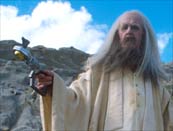
The Cathedral of Monreale: the other great wonder of Sicily made by human hands
Okay, if you've been to see my pictures on Flickr lately you'll see that I was very impressed by the Villa Romana del Casale in the southern inland town of Piazza Amerina. This cathedral was also really astonishing.
Looking up at the ceiling rather than down at the floor of course leads to different comparisons... the inspiration and motive for creating the mosaics for each is also substantially different.
In this case, the patrons are Norman royalty from 1100 AD rather than Greek nobles from 350 AD.. however the labour pool is substantially the same, with artisans drawn from around the Mediterranean, north Africa and the middle east to create a strikingly Byzantine view of Christianity.
Like Icons, the mosaics in this cathedral are surrounded by glittering bling bling in the background - copper tiles with gold leaf.
In the picture above (blurry, hard to capture this place without a tripod and bigger lens), you can see the scenes from the Old Testament book of Genesis -
top row - creation scenes (L-R):
- 'Let there be lights in the vault of heaven'
- 'Let the waters teem with living creatures, and let birds fly above the earth within the vault of heaven'
- 'Let us make man in our own image, in the likeness of ourselves'
- 'God rested on the seventh day after all the work he had been doing'
lower row - Noah and his offspring (L-R):
- 'As flood subsides, Noah disembarks all the animals from the ark'
- Noah and his family make a sacrificial offering to God
- Noah's sons embarrassed by his drunkeness
- The confusing of languages at the tower of Babel (partly obscured)
A team of craftsmen realised the glorious designs on the walls and ceiling of this cathedral. A Byzantine arrangement incorporating elements from a wide range of Mediterranean cultures was achieved with artisans of Greek, Provencal, Roman, Pisan, Arab, Apulian and Venetian origin or training. The name and identity of the chief designer is no longer known, however features of the design point to a person of a Latin background who understood the vision and desires of the Norman patron, King Roger I, as well as fundamentals of Christian theology. The person deserves to be regarded as a 12th-century master of composition and decoration for churches, the way Giotto and Michelangelo were later acknowledged for their respective advances in technique and composition in the 14th and 15th centuries.
Other, smaller churches (Cefalu & Palermo) in Sicily are thought to have superior artistic merit in the composition of their mosaic walls and ceilings. The Monreale Cathedral however remains the largest complete example of mosaic design of this type from the era.
In the central cloister above the altar, a huge likeness of Jesus looms. He has weary, sad eyes, a down-turned mouth and wavy, whorly hair and beard. It could be Evard Munch or Alfons Mucha from the post-impressionist years at the turn of the 20th century. Representations of robes and drapery are detailed; they frequently show plausible folds and weight giving a realistic representation of the arms or legs of the figures under them. This is something Giotto was beginning to master close to 200 years later.
Remarkable too are the sequences where the biblical figures age over time: such as the scene where Eve is molded by God from one of Adam's ribs. The pair are suitably young, plump and fit-looking. Eve could be Kate Winslet, while Adam could be Matthew McConaughey
In a scene that follows, Adam & Eve are banished from the Garden of Eden, looking decidedly scrawnier. Adam is withered and sinewy like a pale Kalahari bushman. Eve is thin and her breasts sag - both have lost their movie star looks and healthy glow. Natural aging in the times before strand-by-strand hair replacement treatment, brassieres and botox. No bongos either!


0 Comments:
Post a Comment
<< Home